1 Introduction to Chinese Scripts and Basic Writing Skills
Part I. Culture
1 Introduction
Calligraphy is much, much more than literally applying brush strokes to paper. It’s an infinitely rich form of art that is thousands of years old, with practitioners who, over the centuries, have blended style and form to enrich China’s history and culture. In its multiple forms of artistic nuance, calligraphy truly is the gateway to China’s “soul.” Without an awareness of what calligraphy represents, one’s appreciation of China will never be realized fully.
Chinese Calligraphy is known as “the correct way of writing Chinese characters” (and it also refers to the completed piece of calligraphy writing). It came into being before the invention of paper and ink, with etchings known as “oracle bones,” that appeared as divine representations on turtle shells and animal bones. As calligraphy evolved, it began to reflect distinctive characteristics of China’s dynasties from as early as 1500 BC. As a result, calligraphy is considered in Asian societies the supreme visual art form, even more valued than painting and sculpture, and is ranked alongside poetry as the highest form of self-expression. Amid rapid-fire change in China and elsewhere, its beauty and self-expression resonate among practitioners. It anchors the present to the past.
Calligraphy as an art form has another feature: It reflects the calligrapher’s own personality, regardless of age or nationality. Practitioners live across Asia and elsewhere around the world. Keen observers, for example, can follow patterns of characters to discern whether the writer was having a good or bad day.
Requiring day-in day-out discipline to master, calligraphy provides enormous aesthetic and emotional benefits to a practitioner. In this digital age of smartphones, laptops and apps, it conveys traditional values through the delicate application of brush to paper. It creates a contemplative, relaxed mood – essential for emotional balance and well-being.
2 Formation of Chinese Characters: Liu Shu (六书/六書/liù shū) – the Six Methods of Forming Chinese Characters
| Category 1 | Category 2 | Category 3 | Category 4 | Category 5 | Category 6 | |
| Name of Character Type | Pictographs | Indicative Characters | Logical Compound Characters | Semantic-Phonetic Compound Characters | Loan Characters | Transfer Characters |
| Example Character | 日,月,木 | 本,刃 | 林,明 | 清,晴 | – | – |
Table 1: Liu Shu (the Six Forming Chinese Character Categories) and examples
From a study of Chinese history, we know that six patterns, or styles, form the basis of all characters. One authority, cited in Shuowen (说文/説文/shuō wén), a Han Dynasty dictionary (206 BC-220 AD) mentions the following:
2.1 Primary Patterns
- Pictograph (象形字/xiàng xíng zì): a character with a semantic element that the ancient Chinese created by “symbolizing” real objects such as animals, plants, and planets. For example:
| for the modern character 日 (sun) | |
| for the modern character 月 (moon) | |
| for the modern character 木 (tree) |
- Indicative Character (指事字/zhĭ shì zì): a character created by adding a stroke
 (an indicator) – to a pictogram to indicate a logical, or abstract, term related to the pictogram’s meaning. For example:
(an indicator) – to a pictogram to indicate a logical, or abstract, term related to the pictogram’s meaning. For example:
Indicative stroke added to the lower part of ![]() (木, tree) for the modern character
(木, tree) for the modern character ![]() (本, root)
(本, root)
Indicative stroke added to ![]() (刀, knife) for the modern character
(刀, knife) for the modern character ![]() (刃, blade)
(刃, blade)
2.2 Compound Patterns
- Logical Compound Character (会意字/會意字/huì yì zì): a character intended to symbolize logical, or abstract, terms with two pictograms that are combined. For example:
![]() (Regular writing: 林) is combined with two trees (
(Regular writing: 林) is combined with two trees (![]() +
+![]() ) to mean “forest.”
) to mean “forest.”
![]() (Regular writing: 明) is combined with the sun (
(Regular writing: 明) is combined with the sun (![]() ) and the moon (
) and the moon (![]() ) to mean “bright.”
) to mean “bright.”
- Semantic-Phonetic Compound Character (形声字/形聲字/xíng shēng zì): a character that combines a semantic element, known as a radical, with a phonetic element that indicates proper pronunciation. The radical is typically a modified pictograph. For example:
清 (pronounced qīng, meaning “clean and clear water,” that is combined with the semantic radical 氵, meaning “water,” and the phonetic component 青, to be pronounced qīng. 晴 (pronounced qíng, meaning “clear sky”) is combined with the semantic radical 日, meaning the “sun,” and the phonetic component 青, (pronounced qīng) that is similar to the combined character’s pronunciation.
2.3 Transfer Patterns
These are character forms that have been created by borrowing characters with a certain meaning or pronunciation. These forms do not follow one particular character-creation pattern. They are few in number.
- Loan Character (Since it’s not a true method to form characters, it has been omitted in this book).
- Transfer Character (Also not a true method of forming characters, so it, too, has been omitted).
Summary
Four types of Chinese characters can be created with meaningful components:
- a pictograph (such as 日, 月, and 木)
- an indicative character (such as 本 and 刃)
- a logical compound (such as 林 and 明)
- a phonetic-semantic compound character (such as 清 and 晴).
3 Major Styles of Chinese Calligraphy Writing
3.1 Oracle Bone Script (甲骨文, “turtle shell and ox bone script”)
As mentioned, rudimentary script discovered on animal bones or turtle shells, known oracle bone script (甲骨文/jiǎ gŭ wén), is the earliest known form of Chinese writing. It is these inscriptions that were recorded during the last nine kings of the Shang Dynasty (商/shāng).
Surprisingly, these later Shang oracle-bone writings also reflect a few contemporary characters in a different style cast in bronze. As early examples of Chinese writing, they relate to modern Chinese script.
3.2 Seal Script (篆书/篆書, “seal script”)
This seal script (篆书/篆書/zhuàn shū) dates to the latter half of the 1st millennium BC. Having evolved from a Zhou Dynasty (周 zhōu) variant, it became the standard formal of writing during the Qin Dynasty (秦 qín). In the subsequent Han Dynasty (汉/漢 hàn), it was widely used for engravings and seals, also known as “chops.”
Types of Seal Scripts
In general a seal script can refer to the following: large, or great, seal script (大篆 dà zhuàn) and the lesser, or small, seal script (小篆/xiǎo zhuàn).When referring to a seal script nowadays it’s understood to mean the small version.
Unified Small Seal Script
Qin system scripts, found on bronze inscriptions dating to roughly 770 to 250 BC, begin to have a consistent, vertically elongated shape. Scholars believe that during this period script-writing became the national standard. It’s a finding the discovery of a wordbook with some 3,300 Chinese characters affirms. Also, this small script is considered the basis for what is known as clerical script.
3.3 Clerical Script (隶书/隸書, “clerical script”)
Even now there is a debate when clerical script, commonly known as “official,” “draft,” or “scribal” script, 隶书/隸書/lì shū, came into being. Some believe that it developed during the Han. But others, based on recent archaeological discoveries, contend that it was in use well before then.
Clerical script characters appear “flat” in shape in contrast to seal and modern standard script. This latter form tends to be taller. Especially noticeable is the flair writers used in horizontal or downward-diagonal strokes, a distinctive pattern of writing that scholars call “silkworm head and wild goose tail” (蚕头雁尾/蠶頭雁尾/cán tóu yàn wěi).
What’s interesting is that even though some early clerical script is difficult to decipher, some later versions can be mastered. And then there are modernized versions: These examples have late Han character traces and are used for dramatic stylistic impact.
3.4 Running Script (行书/行書, “running script”)
Modern handwriting reflects semi-cursive, or “running” script, 行书/行書/xíngshū, in that strokes and, in rare instances, characters “run into” each other.
3.5 Cursive Script (草书/草書, “cursive script”)
Cursive, or “sloppy script”, 草书/草書/căoshū, is a fully or mostly cursive script. To write in this style, a calligrapher does not often lift the brush from a writing surface and, to enhance appearance, modifies and eliminates strokes.
3.6 Regular Script (楷书/楷書, “regular script”)
Regular, or “standard,” script “kǎishū” 楷书/楷書/kǎishū, came into use toward the end of the Han and the maturing of the Tang Dynasty. It got its name because each stroke is distinctive. Because of its easy-to-recognize characteristics, beginners study regular script first.
*
Part II. Calligraphy Writing
1 Brush Holding Techniques
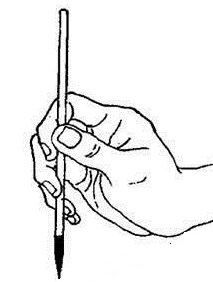
- Principle 1. Hold the brush firmly inside an empty palm (See Figure 1).
- Principle 2. Move wrist – not the arm – to write.
- Principle 3. The smaller the script, the lower point one holds a brush; the less cursive the script, the lower the brush is held.
*
2 Proper Posture and Brush Positioning
When sitting, follow these tips for proper posture:
- Keep head and neck straight but relaxed.
- Keep shoulders relaxed.
- Keep torso straight.
- Keep feet on the ground.
- Write by twisting or turning the wrist of the writing hand (called wrist-directing technique), and keep the un-writing hand on the table.
When standing, place the un-writing hand on the table to support the the body; the upper body should slightly tilt toward the table.
3 Methods About Where to Place the Wrist of the Writing Hand
Methods, in general, depend on a practitioner’s ability to control the brush (when writing) and the size of a character.
- Method 1. 枕腕/zhěn wàn: Rest wrist and upper arm on a table. It is typically used to write small characters. Beginners tend to do this.
- Method 2. 提腕/tí wàn: Lift wrist with the elbow on the table. It is typically used to write medium-sized characters or by experienced calligraphers.
- Method 3. 悬腕/懸腕/xuán wàn: Keep wrist and elbow suspended. It is typically used to write large characters, running or cursive script, or by very experienced calligraphers.
4 Strokes to Compose Characters of Regular Style 楷书/楷書 (the default script for practicing characters in this book)
4.1 Basic Strokes in the Chinese Language
There are 32 types of strokes in regular Chinese character-writing. See Table 2.
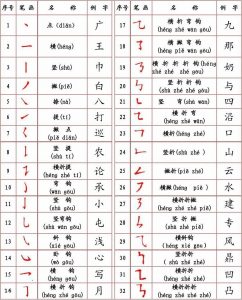
Table 2: Stroke types in regular writing with names in Pinyin and sample simplified characters
(Adapted from https://www.wendangwang.com/doc/cda8da205f4743879691d944.)
Note: The example characters given in Table 2 are the simplified versions even if they have traditional forms.
4.2 Basic calligraphic strokes
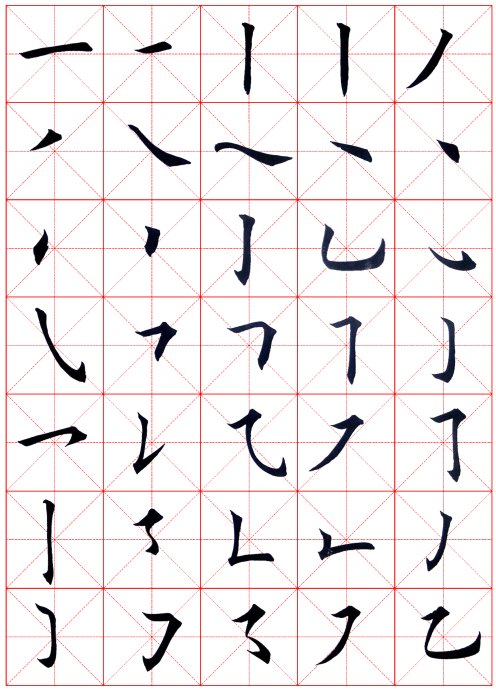
In Chinese calligraphy (in regular style, by default) there are multiple ways to write each stroke normally based on where the strokes appear in a character. The horizontal stroke can be written in at least two ways, for example. And the dot stroke may show more forms in places of a character. Below, see basic calligraphic strokes written by Yunzhang Tian (Table 3).
4.3 Horizontal Stroke 横/héng: A Horizontal Line
There are multiple ways of writing a horizontal stroke based on its real shape in a character. The basic way of writing its common shape is to take three consecutive steps.
*
*
Note: The brush does not leave the paper until the end of the whole stroke.
- Step 1: Direct the brush to write a small triangular stroke beginning from the top-left.
- Step 2: Write the horizontal line body by dragging the brush horizontally but slightly upward.
- Step 3: Finish the stroke with another triangular stroke end.
See the three steps reflected on the stroke below (Figure 2):
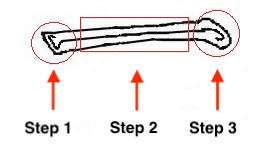
*
4.4 Vertical 竖/竪/shù: a vertical line
There are at least two kinds of vertical strokes. One is called 垂露竖/垂露竪/chuí lù shù, a vertical stroke with the bottom end that looks like a drop of dew. The other is called 悬针竖/悬針竪/xuán zhēn shù, a vertical stroke with a needle-like bottom end. See the two types of vertical strokes below (Figure 3):
 |
 |
Figure 3: 垂露竖/垂露竪 and 悬针竖/悬針竪
*
The basic way of writing the 垂露竖/垂露竪 is to take three consecutive steps (Figure 4).
- Step 1: Direct the brush to write a small triangular stroke beginning from the top-left.
- Step 2: Write the vertical line body by dragging the brush downward.
- Step 3: Finish the stroke with a diamond-like end.
 |
 |
Figure 4: Three Steps to Write A 垂露竪/垂露竪 Stroke with A Real Sample Stroke
The basic way of writing the 悬针竖/悬針竪 is also to take three consecutive steps (Figure 5).
- Step 1: Direct the brush to write a small triangular stroke beginning from the top-left.
- Step 2: Write the vertical line body by dragging the brush downward.
- Step 3: Finish the stroke by gradually lifting the brush.
 |
 |
Figure 5: Three Steps for Writing a 悬针竖/悬針竪 Stroke with a Real Sample Stroke
*
5 Composing Character
An instructor should guide anyone working on this section.
5.1 Stroke Order
Arch Chinese lists 12 rules of Chinese character-writing order (Note: the numbering/order of rules is different from the original on the website). Below are Rules 1-4:
- Rule 1: From top to bottom (e.g., 二 and 三)
- Rule 2: From left to right (e.g., 川)
- Rule 3: Horizontal before vertical (e.g., 十 and 王)
- Rule 4: Cutting strokes last (e.g., 干)
For details, visit the Arch Chinese website. Yellowbridge Online Dictionary can provide additional information. Please note that the actual stoke order in calligraphy is sometimes different from that in regular writing. And the rules only give general guidance. We cannot count on rules to tell the stroke order for all specific characters. Refer to dictionaries when needed.
5.2 Character Writing
Model characters to learn, with character/Pinyin/Meaning below:
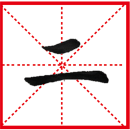 |
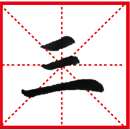 |
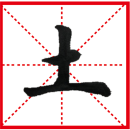 |
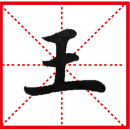 |
Prepare tools and materials. Follow instructions and start to write. Frequently check to make sure posture is correct.
6 Homework
6.1 Purchase writing tools and materials: a medium-sized weasel or mixed-hair brush (狼毫/láng háo or /兼毫/jiān háo), a bottle of ink for Chinese calligraphy (墨/mò), 50-100 sheets of grid rice paper (宣纸/宣紙/xuān zhǐ) for beginners, and an ink stone (砚台/硯台/yàn tái).
6.2 Practice already mastered characters.
6.3 Write 十/shí, 工/gōng, and 干/gān/gàn as follows:
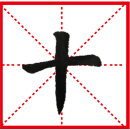 |
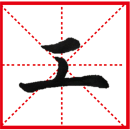 |
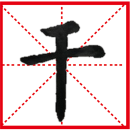 |
*
Part III. Additional Resources
- Chinese Calligraphy http://asiasociety.org/education/chinese-calligraphy
- Kao, H. S., Zhu, L., Chao, A. A., Chen, H. Y., Liu, I. C., & Zhang, M. (2014). Calligraphy and meditation for stress reduction: an experimental comparison. Psychology research and behavior management, 7, 47. https://www.ncbi.nlm.nih.gov/pmc/articles/PMC3928403/
- Interesting video for understanding Chinese characters easily: https://www.youtube.com/watch?v=cbz_g6Kr7D4
- Videos about the history of the Chinese characters: https://www.youtube.com/watch?v=CVvIA5aahN8
- Video of Chinese Calligraphy Documentary: https://www.youtube.com/watch?v=4BzdyBP8NU0
- Appreciating Chinese Calligraphy: https://www.youtube.com/watch?v=MEN0CzGv5-Y

